Ischgl
Understand
Ischgl is a modern Alpine town with a population of ca. 1600 roughly half way up in the Paznaun Valley (Paznauntal) between Galtür and Kappl. It is highly urbanized and touristic, with more hotel rooms than residents, especially popular in winter as a ski resort. It attracts a relatively young tourist demographic, and the town has become popular for its nightlife. Ischgl's skyline is dominated by newly built hotels, giving it a less authentic feel than most other villages and towns in Tyrol.
- 🌍 Tourist Information (Tourismusverband Paznaun - Ischgl), Dorfstraße 43, ☎ +43 50990 100, fax: +43 50990 199, e-mail: info@ischgl.com. M-F 08:00-18:00, Sa 08:00-18:30, Su 09:00-12:00, 16:00-18:00. All tourist information, including free maps of the Silvretta Arena and hiking maps in summer. Free.
History
Ischgl was founded in the 10th century as a farming village. For centuries there was no connection between the upper Inn Valley (Oberinntal) and the Paznaun Valley, and Ischgl's only connection to civilization was through Vorarlberg, its most important trade partner. It was effectively an isolated outpost of Vorarlberg in Tyrol, and the name Ischgl literally means island in the local dialect, reflecting its isolation. Archduke Siegmund understood the difficulties faced by the young Alpine village, and allowed Ischgl to export cattle and import wheat duty free, which boosted its economy from the 1460s. From 1505, Ischgl was allowed to collect toll but in return was required to keep the trade route over the 🌍 Jamtalferner glacier open. This proved to be difficult because of increased rock avalanches and the glacier breaking apart, and by the 18th century the glacier could no longer be traversed by horse, bringing trade almost to a standstill. An exodus followed in the 19th century as a result of the economic hardships brought by the decline in trade, and a famine struck Ischgl. Many villagers fled the famine, relocating to Bavaria or Swabia, and of those who decided to stay, many perished during the harsh winter months as there was insufficient manpower to cultivate enough food and harvest enough firewood.
The barren Paznaun Valley had little economic assets to offer, and unlike in neighbouring valleys, a railway connection was never established. The lack of a rail link cut off Ischgl from the rest of Tyrol and Vorarlberg during winter months, and inhibited expansion of the village which made recovery difficult.
Only by the end of the 19th century, when tourism generated a new source of income, Ischgl started to enjoy economic improvements. Between 1882 and 1889, several Austrian and German mountaineering clubs installed shelters and promoted tourism. Since the 1964, when the first 🌍 Silvretta cable car opened to the public, Ischgl has transformed completely from a millennium of agriculture into a ski resort. With over 10.000 guest beds it is now one of the largest (by bed count) ski resorts in the Alps.
Get in
By bus
Bus 260 connects Ischgl once or twice per hour (depending on time of day) with the other towns and villages in the Paznaun Valley, all the way to 🌍 Landeck-Zams. At the station, take bus 260 on platform C right across the station entrance. The journey to Ischgl takes ca. 52 minutes, and no transfers are needed. A ticket costs €7.40 when purchased in advance online. Get off at 🌍 Ischgl Florianplatz.
For long distance travel options, see Paznaun Valley.
By ski
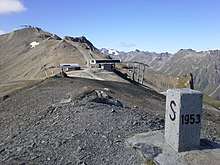
Ischgl can be reached by ski from 🌍 Samnaun in Switzerland, as their shared ski resort spans both towns across the border.
Get around
Ischgl is fairly small, so getting around by foot won't be a problem. To reach the the western village Mathon, take bus 260 at 🌍 Silvrettabahn direction Galtür and get off at 🌍 Mathon Ost or 🌍 Mathon West.
See
Museums
- 🌍 Ropeway Museum (Seilbahnmuseum), Dorfstr. 61, ☎ +43 5444 606, e-mail: office@silvretta.at. W 16:00-19:00. Since 2009 completely renovated, the Ropeway Museum offers visitors an insight in the history of ropeway technology from the 60s to the present, including one of the first gondolas. It also documents the founding period of the Silvrettaseilbahn AG, the company currently responsible for keeping the ski lifts in Ischgl going.
- 🌍 Mathias Schmid Museum, Stöckwaldweg 33, ☎ +43 664 35 79 174. A small museum dedicated to painter Mathias Schmid, born in the Paznaun Valley. On display are numerous drawings, paintings, sketch books, documents, and memoralia connecting Schmid to the Paznaun Valley since 1851.
Churches and chapels
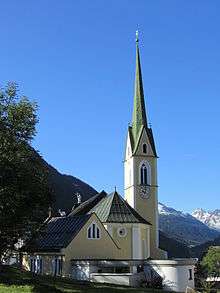
- 🌍 St. Nicholas Church (Pfarrkirche St. Nikolaus), Kirchenweg 7, ☎ +43 5444 5880, e-mail: kathpfarramtstnikolaus@ischgl.at. Church built in 1443 and consecrated as parish church in the 16th century. The Baroque church with Gothic tower is surrounded by a cemetery (German: Friedhof). The ceiling is richly decorated with frescoes from the hand of Anton Kirchebner, added in 1756 and documented by Josef Jais. The Baroque high altar is a design from Josef Georg Witwer, and installed between 1756 and 1757. Most of the paintings were only added in 1813 and created by Alois Grissemann.
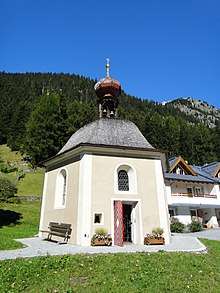
- 🌍 Three Kings Chapel (Dreikönigskapelle), Mathonerstrasse. A Baroque chapel with circular apse and typical onion-shaped roof in Mathon includes a Madonna statue from the mid-17th century attributed to Michael Lechleitner. Free.
- 🌍 St. Sebastian Church (St. Sebastian Expositurkirche), Kirchgasse, Mathon. Baroque church built in 1674 and consecrated in 1782 in honour of Saint Sebastian and Saint Rochus. Free.
- 🌍 Chapel of the Seven Sorrows of Mary (Kapelle Zu den 7 Schmerzen Mariens). The chapel lies in Unterpardatsch in the Fimber Valley (German: Fimbertal) and was rebuilt in 1833 on the site of a chapel dating from the 17th century. It is a two-bay chapel with circular apse and with onion dome on the roof. Decoration consists of numerous votive images from the 19th and 20th centuries. Free.
Do
Winter sports
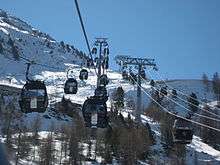
Ischgl's most important attraction is its extensive winter sports facilities. With 239 km of slopes in all difficulty levels, Ischgl offers the largest ski resort in the Paznaun Valley. Skiers have access to reliable snow conditions from November until the beginning of May (although slopes at lower elevations are usually closed earlier). Unique for Ischgl is that skiers can cross the mountain ridge into Switzerland, with connections to Samnaun.
Name Tel. Altitude 





Silvretta Arena +43 50 990 100 1377 - 2872 m 41 Lifts: 7 / 25 / 9 239 km Pistes: 47 / 143 / 49
The 3 lifts offering access to the ski resort are the 🌍 Fimbabahn, the 🌍 Silvrettabahn, and the 🌍 Pardatschgratbahn. Due to Ischgl's popularity as a ski resort, long waiting lines can be expected at each of the 3 lifts as early as 08:00. Waiting times can be up to 1 hour, so it is recommended to either come before the morning rush, or sleep out and join the queue after 9:00. Tickets can be purchased at each of the 3 lifts.
Hamlet 🌍 Mathon does not have a connection to the ski resort, but has its own 🌍 practice lift (German: Ubungslift) which can be accessed with any Ischgl skipass.
For those who can't get enough of snow fun during the day, night sledging is an adventure on its own.
- 🌍 Night Sledging (Nachtrodeln), Paznaunstalstrasse, ☎ +43 50 990 100, e-mail: info@ischgl.com. M, Th 19:00-20:30. A sledging track spanning most of the regular ski slope, including some fairly flat sections that require walking. Ascent is with the Silvrettabahn. Tickets for a single ascent cost €14 for adults and €8.50 for kids. Rental of a sleigh is separate at €9 for adults and €4.50 for kids, making the experience rather expensive since these prices only cover a single decent.
Water sports
- 🌍 Forest swimming pool (Freibad Waldbad), Waldbadweg 6, ☎ +43 5444 5203, e-mail: silvrettacenter@silvretta.at. June-August from 09:00-18:00, closed during bad weather. Outdoor swimming pool in the Stock Forest (Stockwald), with a 47 m long water slide. Open in summer months. Free entance with the Silvretta Card.
- 🌍 Silvretta Centre, Centerweg 1, ☎ +43 5444 606 950, e-mail: silvrettacenter@silvretta.at. 10:00-22:00 daily. Indoor wellness and spa in the centre of Ischgl, with indoor swimming pool at 28°, waterfall, rapids, and different saunas. Adults €16, children €10.
Hiking
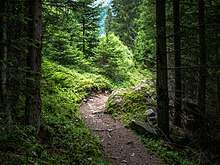
There are ample hiking opportunities around Ischgl in summer, with maps of marked hiking trails freely available in the tourist information centre. The Walk of Lyrics is among the nicest and best signposted hiking tours around Ischgl.

- 🌍 Bear Falls Suspension Bridge (Hängebrücke Bärenfalle). Steel suspension bridge over the Fimba Valley, with the Bear Falls underneath.
Radical sports
- 🌍 SkyFly, ☎ +43 5444 606, e-mail: office@silvretta.at. 10:00-16:00 daily. A 2 km long zipline starting at the Silvrettabahn Mittelstation, and finishing at the Pardatschgratbahn Talstation. There are 2 parallel tracks, making it possible to experience the flight with speeds up to 84 km/h with a friend or partner. Flight time is about 3 minutes, ca. 50 m above ground. €39 for SkyFly and €11.50 for a Silvrettabahn ascent for adults, €25 for Skyfly and €6.50 for Silvrettabahn ascent for kids..
- 🌍 Rafting, Stöckwaldweg 5, ☎ +43 5444 5277, e-mail: hotel@piztasna.at. An adrenaline activity with family or friends, rafting involves the descent of the Paznauner rapid rivers in an inflatable boat (raft) with an experienced guide helping in navigating the most difficult sections of the trajectory. You must be able to swim to participate. Recommended more in summer than in winter due to the temperature of the water.
- 🌍 Canyoning, Stöckwaldweg 5, ☎ +43 5444 5277, e-mail: hotel@piztasna.at. Follow the flow of Paznauner rapid rivers, guided by experienced locals. A canyoning tour involves the descent of white water streams in a neoprene suit, complete with helmet and safety gear, and includes climbing, swimming and jumping. Expect the waters to be ice cold, so mostly recommendable in summer.
Buy
- 🌍 MPREIS, Silvrettastraße 37, ☎ +43 503 219 287 15, e-mail: info@mpreis.at. Winter: M-F 7:30-19:30, Sa 7:40-18:00, So 15:00-19:00; Summer: M-F 7:40-20:00, Sa 7:40-18:00. Decently sized supermarket with a selection of food and drinks, toiletry items, and most other stuff travellers would need.
- 🌍 Billa, Florianpl. 6, ☎ +43 5444 50076, e-mail: info@billa.at. M-F 7:15–19:30, Sa 7:15-18:00, Su 13:00-18:00. Small supermarket close to the bus stop and ski lift, with mostly food, drinks, and snacks.
- 🌍 InterSport, Dorfstraße 31, ☎ +43 5444 5583, e-mail: office@bruendl.at. M-Sa 08:00-18:30, Su 08:00-18:00. Sports store specialized in winter sports equipment, but also sells hiking equipment. Materials can also be rented.
Eat
- 🌍 Restaurant Hotel Tirol, Dorfstraße 77, ☎ +43 5444 5216, e-mail: hotel@tirol-ischgl.at. A traditional restaurant with reasonably priced food and appropriately sized portions.
Drink
- 🌍 Pacha, Madleinweg 2, ☎ +43 690949952, e-mail: elisabeth.schneeberger@hotmail.de. One of the most popular night clubs in Ischgl.
Sleep
Ischgl is a very popular destination for skiers in winter, and especially when snow is falling in abundant quantities, most accommodation will be full. It is recommended to book a hotel room as early as possible. There are very few, if any, AirBnB style facilities in Ischgl so don't count on those as cheaper alternatives.
- 🌍 Hotel Solaria, Dorfstr. 39, ☎ +43 5444 5205, e-mail: hotel@solaria.at. Check-in: 14:00-19:00, check-out: 07:00-10:00. A homely hotel with good food.
- 🌍 Schlosshotel, Dorfstraße 85, ☎ +43 5444 5633, e-mail: office@schlosshotel-ischgl.com. Luxury hotel in a renovated castle, with indoor and outdoor swimming pool, and nearly all other amenities guests would need. No single rooms, but if you're willing to spend this much money, it could be considered for occasions like honeymoons etc. €350.
- 🌍 Hotel Seiblishof, Pasnatschweg 1, ☎ +43 5444 5425, fax: +43 5444-5425-66, e-mail: info@seiblishof.com. Check-in: 15:00-23:00, check-out: 07:00-11:00. Posh hotel with extensive amenities for skiers, most popular in winter. €332.
- 🌍 Hotel Yscla, Dorfstr. 73, ☎ +43 5444 5275, fax: +43 5444 5275-4, e-mail: info@yscla.at. Family run hotel, and one of the cheaper accommodation options in Ischgl. €78 for single room.
- 🌍 Hotel Madlein, Madleinweg 2, ☎ +43 4718 590, fax: +43 4718 590-310, e-mail: info@biohotel-daberer.at. Very posh hotel aimed at skiers. €250.
- 🌍 Hotel Brigitte, Oberer Kirchenweg 3, 6561 Ischgl, ☎ +43 5444 5646, fax: +43 5444 5646-66, e-mail: info@hotel-brigitte.com.
Stay safe
.jpg)
In contrast to the ease with which the border between Austria and Switzerland can be crossed by ski, it is strictly forbidden to cross 🌍 the border in the Fimba Valley with any kind of vehicle. Doing so risks prosecution, although the chance of being caught is very low because there is no formal border check point.
Go next
- Galtür — Alpine village that turns into a ski resort in winter, internationally known for the 1999 avalanche that almost completely wiped it of the map.
- Landeck — transport hub in the Upper Inn Valley, famous for its castle.
- St. Anton — one of the oldest and best ski resorts the Alps.
- Samnaun — a Swiss town outside the Swiss customs area (making it a popular destination for duty-free shopping) which can be reached from Ischgl by ski.